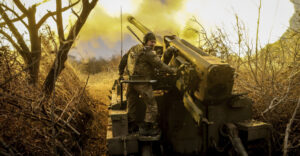Within 72 hours, Ukraine has received approval—formal or informal, though the distinction matters little on the battlefield—from the U.S. and the UK to use advanced weapon systems on Russian territory. Following these “approvals,” Kyiv launched attacks using U.S. ATACMS and British Storm Shadows on Russian targets, particularly in Kursk province.
Kyiv’s actions underscore what analysts and political leaders have clearly stated: Ukraine must go on the offensive. Zelensky has no choice but to strike Russian military positions and supply lines with all available means before they can threaten critical territories and forces.
Kursk and the 1,200 square kilometers under Ukrainian control since August represent the only significant bargaining chip Ukraine holds, particularly if Donald Trump decides to bring both sides to the negotiating table. For two months, Kyiv has paused offensive moves in Russia’s southwestern province, while the Kremlin has deployed North Korean reinforcements to the region with the explicit goal of dislodging Ukrainian forces at any cost. This partnership with North Korea highlights the urgency for Moscow.
Vladimir Putin is determined not to let the Kursk issue remain in focus. He aims to prevent the establishment of a narrative that could endanger large portions of Ukrainian territory currently under Russian control. For Russia, the Donbas valley and the strategic port of Mariupol are non-negotiable and must remain as they are, regardless of U.S. or European interventions.
On the other hand, Kyiv’s use of British, American, and soon French weaponry to strike Russian targets demonstrates its commitment to defending occupied territories within Russia at all costs.
Ukraine and Zelensky have faced this situation before, as all defenders do against a superior force. The disastrous outcome of the Bakhmut defense—where Zelensky’s insistence on holding the city led to catastrophic losses against relentless Wagner assaults—still weighs heavily. It depleted Ukraine’s most skilled personnel, caused a rift between Zelensky and his army chief, and ultimately led to the latter’s dismissal.
The highly popular General Zaluzhny, who spearheaded Ukraine’s defense in Kyiv and later in Kherson, was replaced by the seasoned General Syrsky, but Kyiv was left with less battlefield experience. The Donbas valley remains largely under Russian control, and despite Ukrainian mobilization and training efforts, the tide in these areas is hard to turn. Over the past six months, Russian forces have been advancing at a pace of about one mile per day—much faster than their progress over the previous two years.
It seems Kyiv has learned from past mistakes. The current strategic choice is not only necessary but pivotal. If Ukraine can hold its ground in Kursk over the next two months and maintain its eastern defenses, the diplomatic “arm-wrestling” likely to arise with Donald Trump’s presidency could offer leverage for both sides.
The critical period ahead requires decisive military outcomes. Russia will undoubtedly retaliate against Ukrainian attacks, escalating the conflict further. Air raid sirens across six Ukrainian provinces underscore this renewed intensity.
The possibility of a third world war has resurfaced as a topic of discussion, particularly in Europe. While data and analyses suggest such an outcome is unlikely, the situation’s volatility leaves no room for certainty that it won’t spiral out of control.
Ask me anything
Explore related questions





